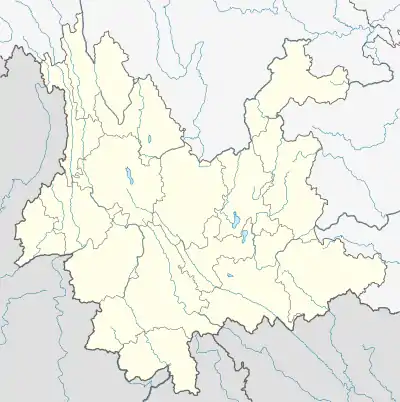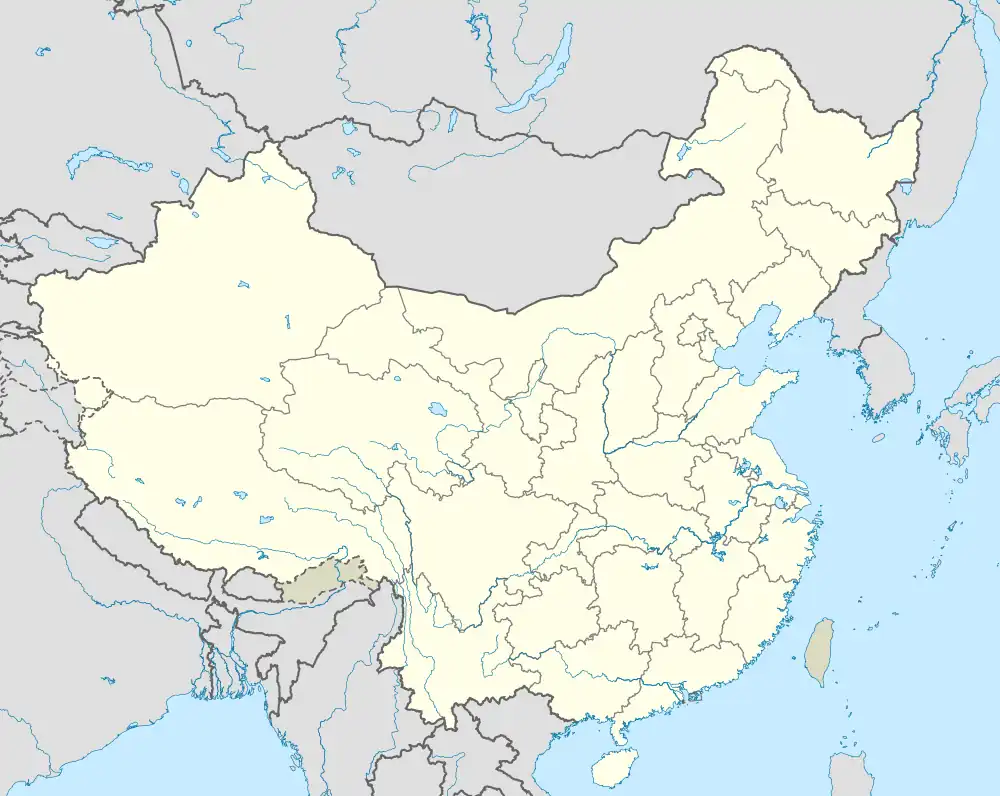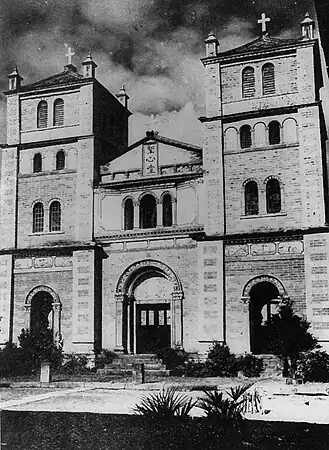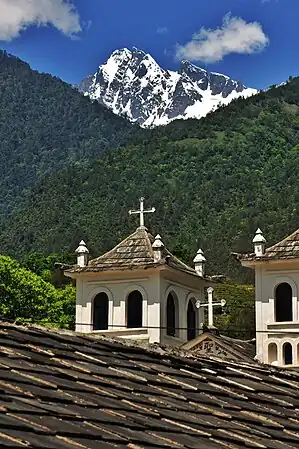| Sacred Heart Church | |
|---|---|
| Sacred Heart of Jesus Church, Bingzhongluo | |
| Zhongding Catholic Church | |
重丁聖心堂 | |
.JPG.webp) The towers of the church in 2011 | |
 Sacred Heart Church  Sacred Heart Church | |
| 28°01′37″N 98°37′31″E / 28.0270°N 98.6252°E | |
| Location | Bingzhongluo, Gongshan, Yunnan |
| Country | China |
| Denomination | Catholic |
| History | |
| Status | Church |
| Founded | 1908 |
| Founder(s) | Annet Genestier |
| Dedication | Most Sacred Heart of Jesus |
| Architecture | |
| Functional status | Active |
| Style | Romanesque Revival |
| Administration | |
| Diocese | Dali (according to Chinese Patriotic Church)[1] Kangding (historically and according to the Vatican)[1][2] |
| Sacred Heart Church, Zhongding | |||||||
|---|---|---|---|---|---|---|---|
| Traditional Chinese | 重丁聖心堂 | ||||||
| Simplified Chinese | 重丁圣心堂 | ||||||
| Literal meaning | Zhongding Sacred Heart Church | ||||||
| |||||||
Sacred Heart Church (simplified Chinese: 圣心堂; traditional Chinese: 聖心堂) or Sacred Heart of Jesus Church (simplified Chinese: 耶稣圣心堂; traditional Chinese: 耶穌聖心堂), commonly known as Zhongding Catholic Church (重丁天主教堂; Zhongding, formerly romanized as Tchongteu or Tchrongteu), is a Catholic church in Bingzhongluo, Gongshan, Yunnan, China. It was founded by Annet Genestier in 1908, destroyed during the Cultural Revolution, and rebuilt in 1996.
History
Original church complex
The French missionary Annet Genestier founded the church in 1908, when the Catholic church turned its missionary focus from Tibetans to the Nu people and Lisu people, but this district was still part of the "Mission of Tibet" and later of the Diocese of Kangding.[3] The funds of the construction came from the compensations of a riot in 1905 (see 1905 Batang uprising), in which locals burnt down the Church of the Sacred Heart of Jesus at Bahang, another church Genestier founded. Before the construction, Genestier himself went to Hong Kong, took photographs of churches, and used them for design. He also hired masons, carpenters and painters from Jianchuan. The construction process of the church complex took 10 years.[4][5]
The original church building was completed in 1918. It was dedicated to the Most Sacred Heart of Jesus. At the time, church complex consisted of the church building and a Siheyuan courtyard with living spaces at the front. The church building originally was made of masonry.[4] According to Tao Yunkui in 1935, the church towers were 24 metres (79 ft) tall, and the church could contain 500 people.[6]
On the outside, the church had a neo-Romanesque facade. The relief sculptures on the facade were carved on white marble (汉白玉), featuring patterns such as iridescent clouds and lotus flowers. The church structure had windows with semicircular arches.[4] On the inside, the church's structure was in Basilica form. There were colonnades of square columns decorated with Corinthian capitals, and some of the pedestals of the columns are in the form of Xumizuo (须弥座). There was also a choir loft above the entrance.[4]
Behind the church, there were a church school and a convent. Both were destroyed during the Cultural Revolution, and their grounds were not returned in 1980.[4]
Chen Haozhou considers the church to be the most valuable Western church in the area before its destruction. According to him, the choice of western architecture for the church reflects Genestier's indignation against the 1905 riot and his devotion to Catholicism. The western architectural style, Chen believed, could be the reason why the original church building was eventually demolished.[4]
During the Cultural Revolution, the original church building was destroyed.[5] The masonry of the church was reused to build the county government, the Shimenguan Hydropower Plant (石门关水电站), and Bingzhongluo's secondary school.[4]
Current church building
The church site was returned to local Catholics in the 1980s.[4] The church building was rebuilt in 1996, and it was expanded in 2006.[6][4] The current church building has one floor and covers an area of 320 square metres (3,400 sq ft). According to Chen Haozhou, it is significantly smaller than the original church.[4] The building is made of brick and timber, and covered in stone tiles. It has a Xuanshan roof, and the two towers have tented roofs.[5] The current church also has windows with semicircular arches.[4] On the inside, there are Chinese-style murals depicting Catholic themes.[5] The new church building no longer has the Basilica form or the colonnades. Instead, there is a walkway in the middle and pews on both sides.[6]
Outside of the church, only the north side building of the Siheyuan courtyard remains. The first floor is the office of the priest and houses a small exhibition about the history of the church. The second floor is used to store religious items. Before the church was rebuilt, villagers attended mass at this building.[4]
Gallery
 Original church building
Original church building The towers of the church in the Nujiang River valley, 2011
The towers of the church in the Nujiang River valley, 2011
See also
References
- 1 2 Lim, Francis Khek Gee, ed. (7 May 2013). Christianity in Contemporary China: Socio-cultural Perspectives. "Routledge Studies in Asian Religion and Philosophy" series. Milton Park: Routledge. pp. 111–112. ISBN 9781136204999.
- ↑ Xu, Jun (2004). "近代天主教在康区的传播探析" [An analysis of the spread of Catholicism in Kham (i.e. East Tibet) in the late modern period] (PDF). 史林 [Historical Review] (in Simplified Chinese) (3): 65. ISSN 1007-1873. Retrieved 4 September 2023.
- ↑ Savioz, Alphonse (2022). "Tibetan Catholics" (PDF). hsstudyc.org.hk. Retrieved 4 September 2023.
- 1 2 3 4 5 6 7 8 9 10 11 12 陈, 灏舟 (2021-06-02). 三江并流区天主教堂本土化特征与共性研究 [Study on Inculturation Characteristics and Commonality of Catholic Church in Three Parallel Rivers of Yunnan Protected Areas] (MA). 昆明理工大学. doi:10.27200/d.cnki.gkmlu.2021.001763. Retrieved 2023-04-08.
- 1 2 3 4 吴, 艳 (October 2012). 滇西北民族聚居地建筑地区性与民族性的关联研究 [Associated Research of Regionality and Ethnicity in Minority Settlements of Northwest Yunnan] (PhD) (in Chinese). Tsinghua University. Retrieved 2023-04-08.
- 1 2 3 单, 军; 吴, 艳; 冯, 晓波 (June 2012). 滇西北偏远地区多民族聚居地天主教堂比较研究 [Contrast Study on Catholic Church in Minority Settlements at Remote Areas in the Northwest of Yunnan]. 华中建筑. 30 (6): 158–161. doi:10.13942/j.cnki.hzjz.2012.06.008.
